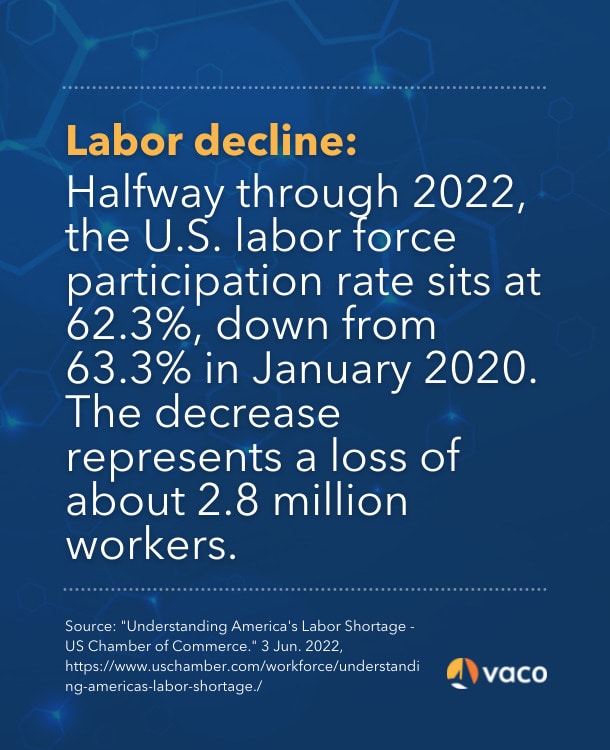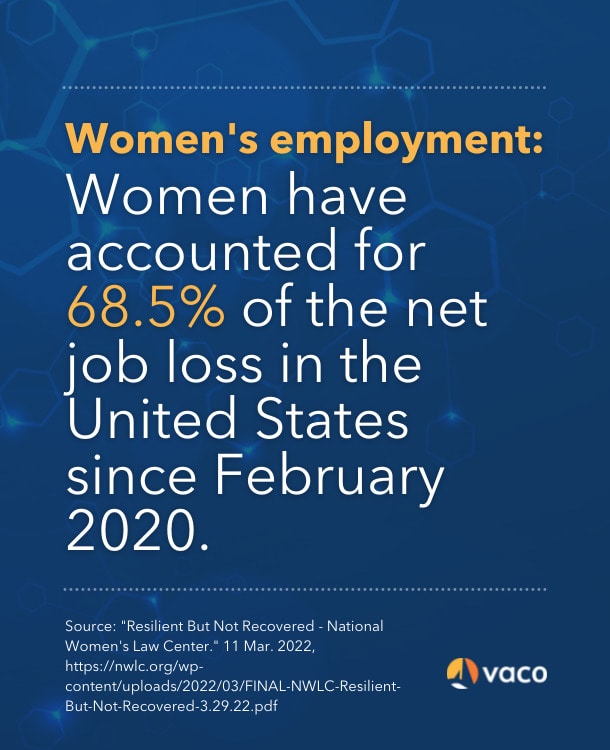There’s no other way to put it: the United States is experiencing the tightest labor market in at least twenty years. Some experts say it’s actually the tightest labor market in the entire post-WWII era. As 2022 has unfolded, the hiring struggles companies faced in 2021 have not only not slowed down, they’ve actually gotten worse.
Here’s some data to illustrate the point: the unemployment rate in the U.S. was 3.6% in April 2022, roughly the same rate we saw in the months preceding the pandemic. As unemployment has gone down, total job openings have accelerated at a breakneck pace. In March 2022, total job openings hit a record high of 11.5 million.
In the same month, the number of unemployed persons per job opening in the U.S. fell to a new twenty year low of just 0.5—that means for every 100 job openings in the U.S. there were around fifty unemployed workers. Even with total job openings taking a dip in April, available jobs still outnumbered unemployed workers by 5.46 million at the end of the month.
The story doesn’t end there. Employee turnover is also adding to the hiring strain. In 2021, an average of four million Americans per month quit their jobs. Over the first quarter of 2022, that average increased each month, before reaching an all-time high in March. This worker exodus is so widespread that it has earned its own moniker: The Great Resignation. It’s also been called the Great Reshuffle, the Great Renegotiation, and the Great Rethink—depending on which market researchers you talk to. However you frame the causes or the impact of rising employee attrition, the fact remains that millions upon millions of employees are voluntarily quitting.
All these things together—low unemployment, record-high job openings, and unprecedented employee turnover—are creating once-in-a-generation hiring challenges for businesses. And while employers know that it’s hard to hire, that skilled candidates are hard to find, and that competition for the very best talent is more intense than it’s been in years, many of them don’t understand why.
In Part 1 of this three-part series, we’re exploring one of the top reasons why hiring companies are struggling to get candidates into their talent pools: there are fewer American workers in the labor force.
U.S. labor force participation is trending downward—for a number of reasons
The labor force participation rate, which measures the number of Americans aged 16 and older who are currently employed or seeking employment, gradually increased through the 1970s, 1980s and 1990s before hitting an all-time high of 67.3% in 2000. Since then, it has trended steadily downward and took a nosedive when the COVID-19 pandemic hit in early 2020. It has yet to return to its pre-pandemic level.
And it might be a long time before it does. The Bureau of Labor Statistics projects that the overall labor force participation rate will decrease to 61.6% by the end of 2022. In the months preceding the COVID-19 pandemic, the rate was 63.3%. As of June 2022, there are 2.8 million fewer Americans in the labor force than there were before the pandemic.
A few factors have contributed to the decrease:
- Approximately 10,000 Baby Boomers reach retirement age each day; by 2030, the youngest Baby Boomers will turn 65. Retirements among U.S. adults aged 55 and older surged during the initial months of the pandemic and have continued at an increased rate in 2022. In a recent survey of Americans who retired during the pandemic, 37% reported retiring 2-3 years early.

- Fewer prime-age adults are working. The labor force participation rate for U.S. adults of prime working age—25-54 years old—remains below pre-pandemic levels.
- Population growth has slowed in the United States over the past two decades; 2021 was the first year since 1937 that the U.S. population grew by fewer than one million people. That’s the lowest numeric growth since at least 1900.
- Enrollment in full-time, four-year universities has increased significantly since 2000. However, only 62% of students complete their degree program in six years or less. These trends have contributed to a lower labor force participation rate among younger adults, especially as the percentage of jobs requiring at least a four-year degree has far outpaced the percentage of U.S. adults who have earned a degree over the past three decades.
The pandemic continues to keep qualified individuals out of the labor force
The COVID-19 pandemic remains a key contributing factor to decreased labor force participation in 2022.

A recent survey from CNBC found that nearly one-third of survey respondents who retired early during the pandemic did so because of concerns over contracting the virus. In June 2022, the BLS reported that, among people not currently in the workforce, 610,000 were prevented from looking for work by the ongoing pandemic—up from 455,000 in May 2022.
The labor force participation rate of women has been disproportionately impacted by the pandemic. A study from the National Women’s Law Center reported that women have accounted for 68.5% of the net job loss in the United States since February 2020. As of February 2022, over 1 million of the women who left the labor force during the pandemic have not returned.
Caregiving challenges—created by in-person school shutdowns, daycare closures, and the severe health risks faced by older adults—have played a huge role in the decision of millions of women to leave the workforce during the pandemic. In the previously mentioned study from the National Women’s Law Center, 26% of mothers with children under five reported quitting their jobs or ending their job searches when in-person school was discontinued or when child care was unavailable. Just 8% of fathers said the same.
Concerns over infection and the threat of serious illness are also on workers’ minds, especially as numerous companies announce organization-wide mandates for returning to the office full-time.
How can employers address issues caused by shifts in the labor force?
Attracting candidates during a labor shortage requires employers to make significant changes to their recruiting and hiring methods, as well as their compensation packages.
The top method for reattracting people to the workforce is money. In one survey of U.S. adults not currently in the workforce, 54% said a good salary is their top motivator for accepting a job.
Employers may also need to revise their benefits, employee perks, bonus plans, and policies regarding remote work. Flexible hours and work-life balance, in fact, were the second- and third-most motivating factors for getting discouraged workers to return to the workforce.
As labor force participation continues to decline, many companies will need to pivot their hiring strategies altogether. Rather than pursue full-time employees for long-term roles, many employers will need to lean on managed services solutions, contract employees and consultants to fill the gaps on their teams.
At the same time, employee retention is already a crucial focus area for employers and will only grow in importance over the coming months and years. With record numbers of employees resigning from their jobs, many hiring companies are facing struggles with filling new positions and backfilling roles left vacant by departing team members.
It’s vital for companies to revisit their employee retention strategies and take an honest account of their successes and failures. Take a deep dive into policies that are linked to employee burnout, low morale or lack of engagement. Beef up programs that empower team members to build their skills or advance in their careers. Perhaps most importantly, make an effort to provide true flexibility and support to your employees—whether that’s a company-wide health initiative, flexible hours and scheduling, or more generous PTO.
Check out the other articles in this series to get even more insights on the current talent shortage:
The hiring and recruiting experts at Vaco help companies of all sizes find top talent for a variety of roles, whether they’re remote, hybrid, or on-site. Learn more about our expertise or reach out to our talent specialists to see how we can transform your hiring efforts.
If you’re a candidate searching for your next dream job, Vaco is here to be your partner and career advisor throughout your professional life. Explore our job seeker resources for interview tips, advice on writing your resume, and downloadable resume templates to help you put your best foot forward in your job search. If you’re ready to work with an experienced career expert during your job search, reach out to us today.
Learn more about our authors:
- Rusty Williams, Senior Director, Technology Solutions at Vaco in Atlanta
- Mike Christoferson, Senior Director of Sales, Technology Solutions at Vaco in Atlanta

Interested in learning more?
Subscribe today to stay informed and get regular updates from Highspring











